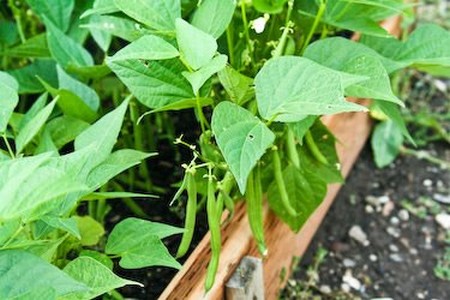French (green) beans are among the oldest type of cultivated bean. They originated in Central and South America, where evidence suggests that they were being grown at least 8,000 years ago. They did not reach Europe until the 16th century, when they were introduced by the returning Spanish. The English name “French beans” presumably derives from the fact that the beans were introduced into Britain from France.
Cultivation
There are several distinct forms of French (green) beans, the most obvious distinction being between the dwarf and climbing varieties. Recently, climbing varieties have become a popular alternative to runner beans and this makes them seem to be a modern development, but, in fact, they are the older of the two types, dwarf beans not having been widely grown until the 18th century.
French (green) beans are either eaten whole, while the seeds are still immature, or grown on and the seeds dried and used as haricot (navy) beans. Some varieties are better for drying than others. Pods vary: they can be green, purple or yellow, and they can be round or flat. The flat varieties tend to be more succulent, and the flat ones often become rather stringy when they become old.
Like runner beans, French (green) beans are frost tender and need to be sown or planted out after the last frosts. They also need warm soil in which to germinate and thrive. They are, however, quicker to mature than runner beans and so provide a valuable early crop. They also have a quite different flavour and so bring welcome variety to the kitchen.
Dwarf varieties are still the most popular, especially as they do not take up much room and are useful in small gardens. In addition, the yield is high and the season for each sowing is relatively long. The climbers or pole varieties are a useful alternative to runner beans because of their different taste and earlier harvest and also because they do not become so stringy. The variety of coloured pods makes them valuable in the ornamental kitchen garden.
Cultivation
French (green) beans, both dwarf and climbing, need a sunny, open site. The soil should be fertile but free-draining, preferably manured during the previous autumn. An early start can be made by sowing the beans in pots or modules under glass in late spring and planting out after the threat of frost has passed. Alternatively, they can be sown directly into the soil and covered with cloches. Most gardeners, however, tend to wait until early summer and sow directly into the soil, when the conditions should be perfect. Sow in a single or double row, spacing the beans about 8cm apart in rows set 45cm apart. They should be planted about 4cm deep. Climbing or pole varieties should be treated in the same way as runner beans. Keep watered in dry weather.
Harvesting
Harvesting can usually begin seven or eight weeks after sowing. Pick while the seeds are still immature and go on picking for as long as the beans cook and eat well. Leave those that you want to treat as haricot (navy) beans until the pods have swollen and turned yellow. Cut the whole plants and hang them up in a dry place to complete the drying. Shell and store.
Storage
French (green) beans are best used fresh from the plant, but they can be frozen, which is a good way of dealing with a glut. Haricot (navy) beans should be dried and stored in airtight jars.
Pests and diseases
On the whole French (green) beans are not prone to many problems. Slugs and snails ate the most likely nuisance, especially when the plants are first emerging, but they can also eat the pods as well. Blackfly and fungal diseases may also be a problem.
